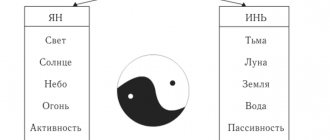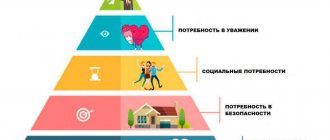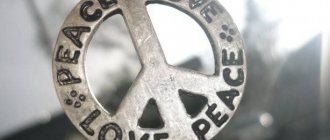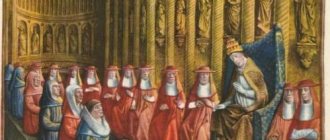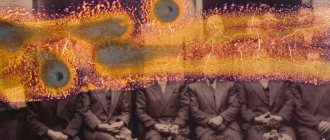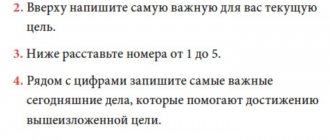Yin is impossible without Yang, Yang is impossible without Yin. This is a connection between body and mind, a union of complementary forces and energies, feminine and masculine. It is a balance between good and evil. This is the understanding that in everything good there is something bad, and in everything bad there is something good. This is the ideology of life, culture and religion.
Heaven and earth, day and night, ebb and flow... Have you noticed that there are many things that depend on each other for their existence? This is the Yin-Yang principle. Chinese philosophy says exactly this: there are always two opposing forces that are in harmony with each other.
The principle of Yin and Yang is found in the Chinese “Book of Changes” (I Ching). The main religious or philosophical context is Taoism, and although this may all seem a little strange, the basic idea is very simple: all things have a necessary polar opposite.
According to the Yin-Yang philosophy, two opposing forces always alternate: a high phase is followed by a low phase, movement is followed by rest, and so on. You've probably already experienced this in your daily life. After all, some days you feel better, and other days you have little energy and are in a bad mood.
Yin and Yang, what does this symbol mean?
What are Yin and Yang? These are two opposite principles in nature, Yin阴means feminine and negative, Yang阳means masculine and positive.
Yin and Yang theory holds that everything in the universe has opposing and united aspects of Yin and Yang, constantly moving and interacting. This type of movement and interaction is the root of all movement and change.
The most primitive point of the Yin and Yang theory is to find the laws of nature in the world and make people obey these laws. The simplest way to reflect the change of Yin and Yang in nature is day and night. The change of day and night is regular, every day is the same. The Chinese call the place where there is sun exposure - Yang, and the place not exposed to the sun (there was shadow) - Yin.
The ancients classified everything according to Yin and Yang, for example:
Yang : sun, light, sky, activity, time, east, south, left, ...
Yin : moon, shadow, earth, peace, space, west, north, right, ...
From the above words, we can see that there are more positive words that belong to Yang, and more negative words that belong to Yin, although this is a natural phenomenon. The Chinese worship Yang more and oppose Yin, as people who adore the sky and the sun more than the earth and the moon.
Symbolism of Yin-Yang:
There is a basic relationship between Yin and Yang. And they consist of 4 main aspects:
- Yin and Yang are opposites.
Yin and Yang are essentially opposites and contradict each other. Things have Yin and Yang attributes, so things with different Yin and Yang attributes are also opposite.
- Yin and Yang interact.
There is interdependence and interaction between Yin and Yang.
- There is a balance between Yin and Yang.
Everything is in absolute motion. Yin and Yang in the Universe are constantly changing.
- There is a mutual transformation between Yin and Yang.
Under certain conditions, Yin and Yang transform into each other.
Energy personality type test: who are you - Yin or Yang?
It is very important to achieve balance - to balance Yin and Yang. To do this, you need to understand what kind of energy you belong to. We suggest doing this using our simple test. Look at the table and write down those letters whose statements you agree with.
A predominates
Element – yang
Element – tree
Noisy, bright, energetic personality.
Strength: You are full of enthusiasm, able to captivate others with your ideas and lead others. You are brave, truthful, open to everything new.
Weakness: You are impulsive and can be harsh in your communication. Your body is susceptible to insomnia, respiratory diseases, and bouts of irritation. You may suffer from high blood pressure, PMS.
B predominates
Element – yang
Element – fire
An extrovert who tends to make rash decisions.
Strengths: Sociability, generosity, charisma, reliability.
Weakness: Anger attacks, stubbornness, hyperactivity. Stomach diseases due to irregular nutrition, gall bladder problems, dry skin, respiratory diseases.
Predominantly B
Element – yang-yin
Element - earth
Rational type of thinking, calmness. Positive attitude towards life.
Strength: Stability, measuredness, a reasonable approach to everything.
Weakness: Slowness in making decisions, slowness, phlegmatic. Due to lack of digestive energy, stomach problems, excess weight and cellulite occur. Possible risk of developing diabetes.
G predominates
Element – yin
Element – metal
A person with well-developed intuition, an introvert.
Strength: Calmness, rich inner world, sincerity, restraint in expressing emotions.
Weakness: High sensitivity to stress. Tendency to avoid solving problems, withdrawing into oneself, anxiety attacks. The body may suffer from lack of appetite, back pain, excess weight, allergies.
D prevails
Element – yin
Element – water
Sensitive personality, prone to mood swings.
Strength: spirituality, empathy, artistry, gentleness of character.
Weakness: capriciousness and laziness, sensitivity to any life challenges. Cold allergies, chronic fatigue syndrome, lack of appetite and desire to exercise. Anxiety, depression. There may be problems with reproductive health, kidneys, and veins.
Do you want to learn how to build your natal chart to see your hidden potential and purpose, know your weak and strong points and upgrade them to avoid many problems? Register via the link to our free webinar, where we will tell you how to create your own individual horoscope and learn how to fulfill your desires using a special technique.
Basic concepts defining the nature of Yin and Yang
The two halves (male and female) form a single whole - this is the sign of Yin and Yang, therefore it is a circle divided into two tear shapes of opposite colors: black and white. The right side, black, goes down and the left, white, goes up, creating a clockwise movement pattern. Since the circle is a whole, the two halves cannot be complete without each other.
Colors:
- White - symbolizes enlightenment.
- Black - symbolizes its direct opposite or deception.
Ancient Chinese philosophers and scientists understood that the world is in a constant state of change, but that it moves through different frames of cycles, each of which has opposite and equal value:
- day and night;
- cold and warmth;
- birth and death;
- Sun and moon.
By exploring this world of constant cycles, the rules of life became apparent and confirmed the theory that opposites must exist to create a whole. Yin (black) is considered the essence of feminine energy, and Yang (white) is considered masculine.
The Yin-Yang of life becomes the last divine circle:
- Night becomes day and day becomes night again.
- Birth ends in death and death ends in rebirth.
Both halves of the symbol are curved and this creates a sense of movement as the halves taper into a tail effect. Yang, the left side, is white, and Yin, the right side, is black. This represents the opposing qualities of the two energies.
It's important to note that inside each curved half there is another very small circle. This small inner circle is the opposite color and corresponds to the opposite half. The small dot symbolizes how each side depends on the other for its existence.
The smaller circle also represents the transformation brought about by coexistence and dependence on each other. This is a wonderful sign to show how everything is connected and nothing in life is lonely. Every person, animal, plant, element, etc. depends on others for their existence. Nothing can exist on its own.
The Yin-Yang sign is a symbol of integrity. This unity and union is created by the other half of matter, which is the opposite half. This is the law of nature and the only way that any individual being or element can achieve wholeness.
Unity is the promise of the circle. Yin must have Yang, and Yang must have Yin, otherwise there can be no life. There can be no balance.
In Taoism, this circle represents the most basic elemental energies of women and men, which are the energies of all creation.
It is easy to get confused as to which of the two symbols is Yin and which is Yang. Equally difficult is remembering the elements that accompany each one.
It's easy to remember that Yin means the dark side. The shaded side of the mountain always faces north. The shaded side is dark and corresponds to the black side of the Yin-Yang symbol.
Yin and Yang origin
Yin and Yang are an ancient philosophy of China and the central element of logical thinking in Chinese civilization. This is a description of the fundamental factors underlying the laws of nature that contributed to its development and changes in ancient China.
Ancient Chinese thinkers believed that everything in the universe consists of two mutually opposing and interdependent aspects. These two aspects are called Yin and Yang. Today, the Yin-Yang theory continues to influence the current lives of the Chinese in many aspects such as the use of colors, love, medicine, architecture, etc.
The Yin-Yang symbol is called a Taijitu or Tai Chi diagram. It represents the philosophy and principles of positive and negative or opposing energies such as masculine and feminine. The word taijitu means diagram of the highest limit.
The origin of the Yin and Yang symbol is controversial, but many believe that it comes from the second “phrase” (calligraphy) of the I Ching called “Book of Changes.” The book places the sun at the top and the moon at the bottom. The modern symbol is a stylized interpretation of this character.
It is interesting to note that this symbol appears on Roman shields. The badge was used to indicate which region the army was assigned to, so it became a regional badge.
There is no historical evidence to indicate any connection between the Romans' use of this symbol and the Chinese use of the Yin-Yang symbol.
Another stylized symbol on the Roman shield was three circles, one inside the other and cut in half. The outer circle on one side was a dark shade, and its opposite side was a lighter shade. The next half of the circle was light, the opposite half was dark, and so on.
- 3rd century Celtic art depicts a similar symbol, which is not always shown in opposing colors.
- The South Korean flag has a two-color Yin-Yang symbol and is depicted with halves on top of each other rather than side by side.
First impulse
Yang is the essence, the core, the idea, the first expressed impulse. But only if Yin accepts and supports it, development will begin: the content will be embodied in form; original strategy will be combined with daring tactics; in a creative takeoff, the Mind will unite with the Heart, and the new creation will delight the Souls; The sperm will penetrate the egg, and the miracle of creation will happen...
What if it doesn’t affect his feelings or emotions? Will he develop a desire to give back? No, because his Masculine Principle is not stimulated.
So from whom does the first impulse come?
In the subtle World, in the Divine game of Yin-Yang, everything is initiated by the active Female Hypostasis of the Spirit, the Will of God the Mother. In Indian philosophy she is called Shakti.
This She, and not the mind that ascribes authorship to itself, accomplishes everything. Without realizing it, it is to Her that we call when we pray or ask Heaven for help. It fills with energy, corrects, guides, transforms, inspires. The refined awakened consciousness, vibrating at a frequency where there is no mental “I,” feels Her messages and follows them.
In the physical world, everything happens by analogy - the implicit first aspiring stimulus comes from the woman.
Yin and Yang of spirit and soul
Yin-Yang in Taoist philosophy is a symbol of the connection between body and mind and, on the other hand, a symbol that connects a person with the entire universe.
These two concepts also communicate that we are energy with two forces, one physical and the other spiritual, but both united in one body.
The symbol fully represents the force that pushes all phenomena from maximum points to minimum points and vice versa, and is the impetus for change and evolution.
The most important thing to remember, and the hardest thing to understand, is that everything, every phenomenon, contains both aspects of this duality, just in different degrees of manifestation.
These concepts have been revealed to be very useful for better explaining and understanding how certain phenomena work, but they are also widely used in many disciplines to study the functioning of our body.
Just as Yin and Yang are inseparable, so are the soul and body. When we talk about Yin-Yang and the body, it is important to distinguish between two types of holistic approach: one refers to position, and the second refers to type and function.
In the first case we find:
- Yang : back, outer limbs, supra-umbilical, posterolateral, organ functions, protective energy.
- Yin : chest, inner limbs, subsections, inner medial part, organ structure, nutritional energy.
Thus, the position can already indicate the relationship of one part of our body with another in a fairly simple and intuitive way.
Another method used relates to the organs and viscera: the former are considered Yin and the latter Yang.
Organs and internal organs differ from each other in the functions they perform (Yang), which, as such, ultimately influence the structure itself (Yin).
- Yin: liver, heart, pericardium, spleen-pancreas, lungs, kidneys.
- Yang: Gall Bladder, Small Intestine, Triple Warmer, Stomach, Large Intestine, Bladder.
Roles
Based on all of the above, their distribution is clear to us. Feminine energy is a guide to action, masculine energy is the act itself and its result. At the same time, the absence of one half makes life incomplete, one-sided. The feminine principle and the masculine principle are inseparable. Their merging, the 50/50 distribution of their roles is the ideal formula that everyone should strive for.
Man is a same-sex creature. We are born female or male, trying to fully follow the criteria imposed by society and stereotypes. That is, if you are a girl, you must be whiny, sensitive and tender. When you are a guy, then your duty is to have courage, firmness, determination, an analytical mind, and logic. Of course, our gender influences our character and way of life: in the middle, what is inherent in nature prevails. Our task is to activate the other, “alien” half as much as possible and try to integrate its capabilities into our everyday life.
The forces of Yin and Yang in everyday life
The relationship between the two forces is also practiced in Traditional Chinese Medicine. Here organs are divided into active and passive functions. Yin, for example, corresponds to the heart, liver and lungs, while Yang is found in the stomach, intestines and bladder. Therefore, in traditional Chinese medicine, the activities of individual organs are coordinated in the best possible way.
Therefore, Yin and Yang are much more than a small symbolic sign and can be found around us every day. After all, contrasts are everywhere.
And a few words about flowers.
The symbol that immediately comes to mind when we think of Yin-Yang is made up of white and black parts. The black zone (Yin) represents darkness, calm, passive perception, feminine and soft. On the other hand, the color white (Yang) symbolizes the sun or radiance and warmth, active dedication and masculinity.
Moreover, you will also find this difference in yoga: Yin yoga consists mainly of rest and breaks. Therefore, all movement-oriented variations such as Hatha Yoga or Bikram Yoga are considered a type of Yang Yoga.
Talismans Yin and Yang
In the Western world, Yin and Yang have become popular in Feng Shui, which means wind and water in Chinese. In its original sense, Feng Shui is an idea of Taoism and refers to the harmony that should exist in space, specifically the harmony between Yin and Yang.
This Taoist philosophical principle has been adapted by Western mentality to seek balance in the distribution of the home (furniture distributed in a certain way and according to the orientation of the cardinal directions).
The Yin-Yang symbol also has a decorative dimension and application, as it is a very common design in the world of tattoos, jewelry and decorative elements.
Finally, it must be remembered that Yin and Yang have certain similarities with some Western philosophical approaches (the struggle of opposites of Heraclitus or the concept of dialectics of philosophers such as Plato or Marx).
The Yin-Yang symbol indicates the balance of forces. Simply put, we can say that in everything good there is something bad, and in everything bad there is some good. In this sense, Yin-Yang resembles the idea of balance between opposites, since for one thing (for example, light) to exist, there must be an opposite (darkness).
The energies of Yin and Yang show that life is an illusion because things are often not what they seem. In fact, situations and people are often the opposite of what we believe or assume.
Natalia Shakhova
Acceptance is a necessary condition for harmonious relationships
Since Yin is the receiving principle, its energy is directed inward.
And this prevailing energy in a woman determines the task entrusted to her by the Creator:
to create harmony in the internal space of the family and maintain peace and harmony in it.
And the Yin power helps her with this. Based on this, first of all, a woman, entering into an alliance with a man, should think about whether she is ready to accept the chosen one with all his pros and cons - not only with the qualities that delight her, but also with the things that stress her out. Will she be able, without losing or suppressing herself (!), to let his interests, hobbies, habits, his family and the burden of his past into her life?
As for a man, when he does not pay due attention to the desires and aspirations of his beloved, even if through her efforts this does not disturb the atmosphere in the house, he stops in his development: his Yin does not awaken. And it’s not hard to guess what happens when in a pair one moves forward and the other gets stuck in place.
And in awareness, Acceptance becomes effortless and natural. To do this, you simply need to remove “I” from any process, that is, thoughts and ideas about yourself.
Along with them, the assessments of others go away. What we call personality disappears with its labels “right-wrong”, “good-bad”, “like-dislike”, with its ideas of how everything should be. And there is no subpersonality that is dissatisfied with something, there is no mental character that must accept something, or wants to change something in another (we are not talking about drunkenness, drug addiction, gambling and other painful addictions).
And if a disagreement arises in everyday life, it does not flare up without a “second one.” And in awareness, since there are no thoughts, there are no emotions, and inner peace is not disturbed. There is no “I’m offended/I’m suffering” character. And in the pure space of consciousness, clarity appears, which “I” forced a dear person to say so, or how hurt self-esteem, in defense, forced me to react this way. And compassion is born for the pain that he/she experiences, and respect for those strengths that balance weaknesses.
